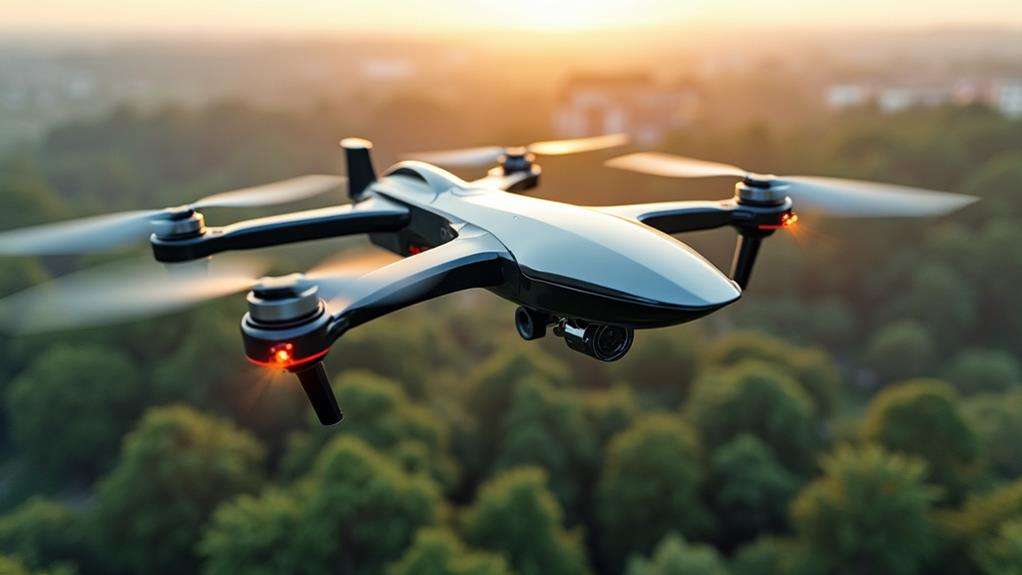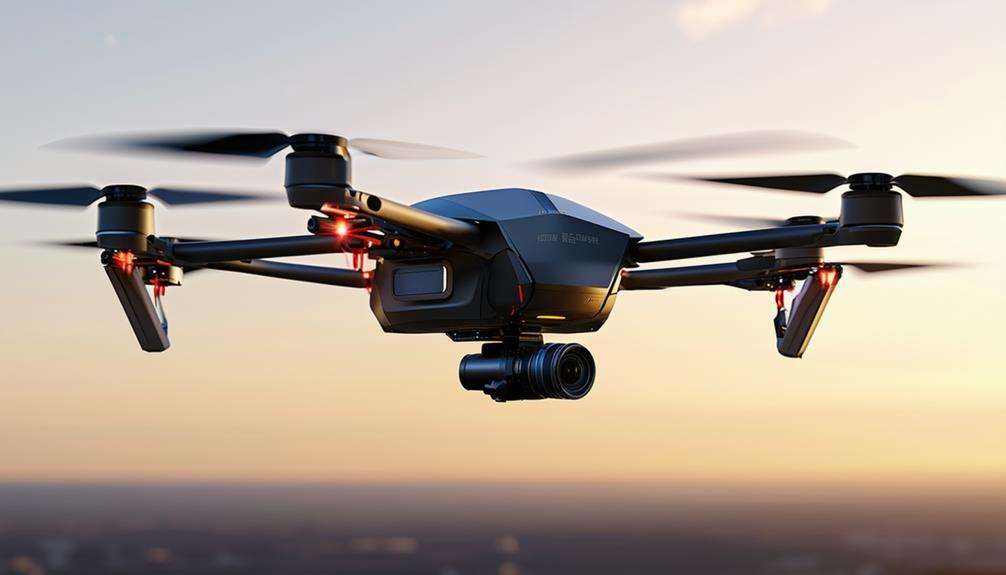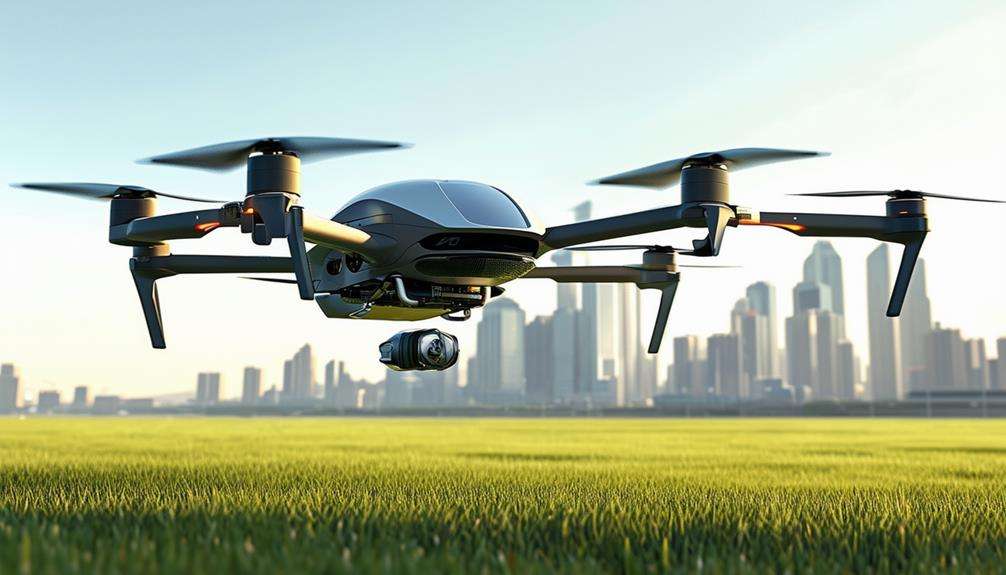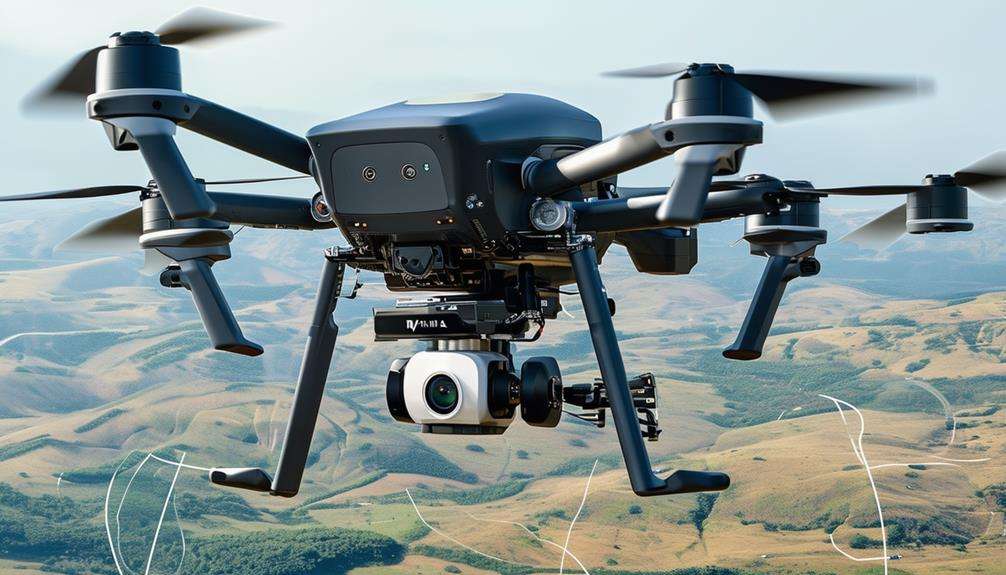How Anti-Drone Technologies Work
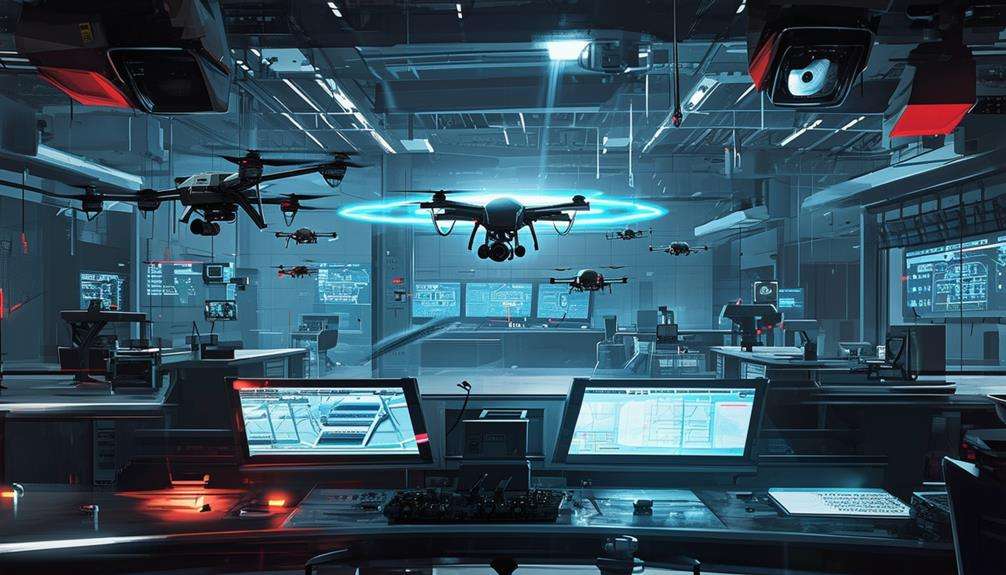
Anti-drone technologies manage to detect and neutralize unauthorized drones in crowded airspace using a combination of radar, radio frequency analysis, and optical sensors. These systems can even operate in low-light conditions.
Detection is only the first step; disrupting or neutralizing drones involves sophisticated measures such as jamming devices, GPS spoofing, and high-energy lasers. Each component plays a vital role in these security measures, working together to provide comprehensive protection. So, what's the next layer of this technology?
Detection Systems Overview
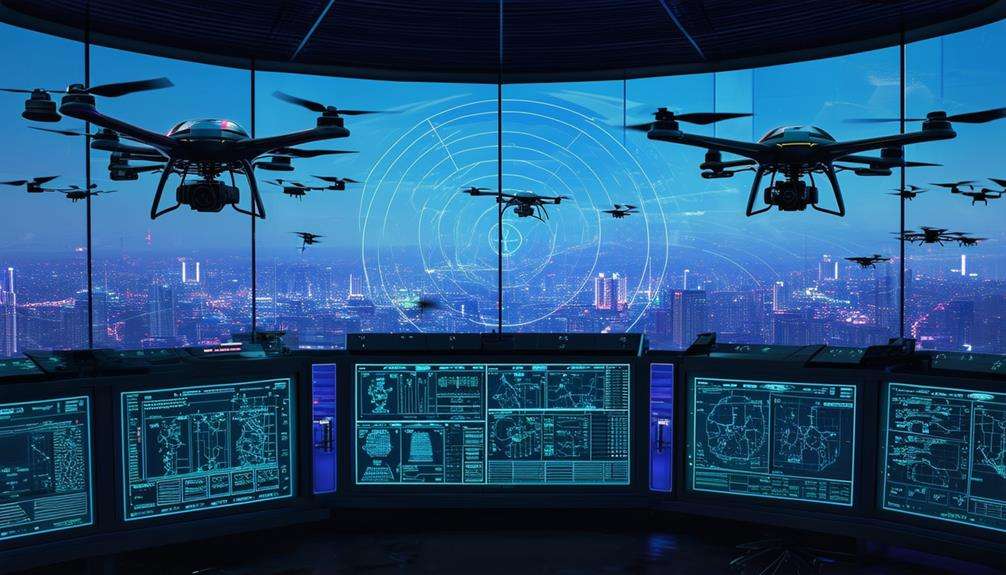
Detection systems in anti-drone technology utilize radar, radio frequency, photoelectronic, and infrared technologies to accurately identify and track drones. These systems are essential for effective anti-drone measures, enabling the prompt and precise detection of unauthorized drones. Radar technology is crucial, as it uses radio waves to determine the position and movement of drones in real-time, allowing continuous and effective airspace monitoring.
Radio frequency sensors are another vital component. They analyze wireless communication signals between drones and their operators. By intercepting these signals, unauthorized drone activity can be identified and tracked, maintaining a proactive stance against potential threats.
Photoelectronic sensors enhance detection capabilities by using visual imaging to spot drones. These sensors are particularly effective in daylight, providing clear visual confirmation of drone presence.
Infrared sensors detect drones based on their heat signatures, making them invaluable for tracking drones in low-light or nighttime conditions, thereby completing the detection network. Together, these technologies create a robust anti-drone system, equipping users with the tools needed to identify and respond to potential drone threats effectively, ensuring airspace security.
Radar Technologies
In anti-drone systems, radar technologies employ radio waves to identify and track drones with exceptional precision. By emitting radio waves and analyzing their reflections, radar systems can detect drones based on their reflective properties, enabling precise real-time tracking essential for effective counter-drone operations.
Radar technology can differentiate between drones and other objects in the airspace, significantly reducing false alarms and ensuring that only genuine security threats are addressed. Doppler radar is particularly noteworthy, as it detects drones by analyzing their movement patterns, helping to distinguish them from birds or other flying objects and enhancing the reliability of the detection process.
Early detection is a key function of these radar systems, allowing for the timely deployment of appropriate countermeasures. This early warning capability is crucial for maintaining the security of sensitive areas. Therefore, when considering counter-drone technologies, radar systems offer a robust and reliable solution for detecting and tracking unauthorized drones, ensuring airspace security.
Radio Frequency Analysis
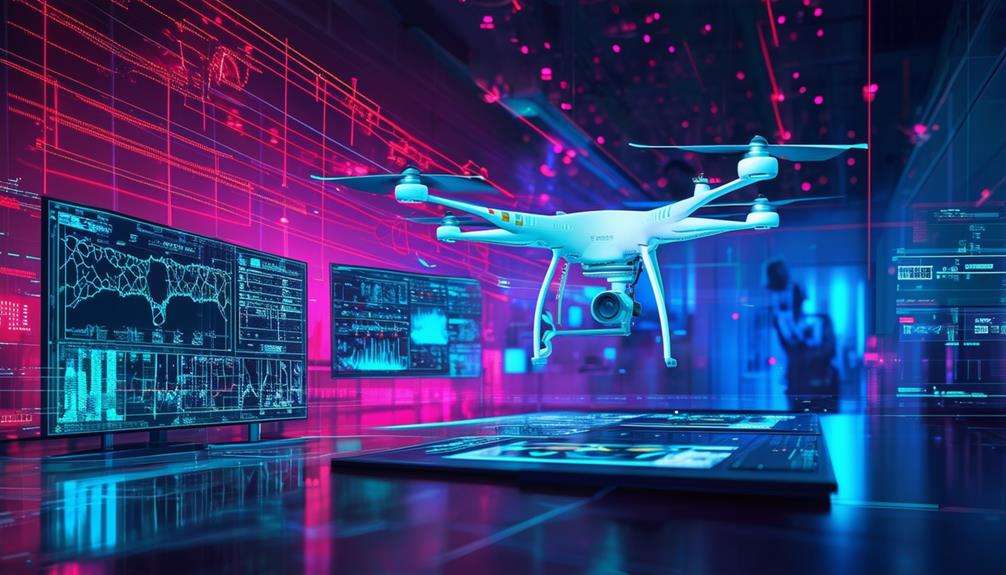
Radio frequency analysis can be employed to detect and monitor drones by analyzing their communication signals. This technology enables the differentiation between authorized and unauthorized drones, thus aiding in the identification of potential threats. Additionally, signal interference techniques can be used to disrupt the communication link between a drone and its operator, effectively neutralizing unauthorized flights.
Signal Interference Techniques
Radio Frequency (RF) Analysis is crucial in Anti-Drone Systems, enabling them to detect and disrupt unauthorized drone communications by targeting specific radio signals. By monitoring and analyzing RF, these systems can identify drones based on their unique communication patterns and frequencies. RF analysis is fundamental to Anti-Drone Systems, facilitating effective drone detection and preventing unauthorized operations.
Once a drone is detected, signal interference techniques are employed. These methods disrupt the radio signals between the drone and its operator, neutralizing the threat. By jamming or spoofing communication frequencies, anti-drone systems can render the drone inoperative, preventing it from completing its mission. This is particularly important for protecting sensitive areas and thwarting malicious activities.
Through RF analysis, anti-drone technologies can effectively counter unauthorized drone flights. Signal interference techniques ensure that once identified, a drone can't continue its operation. This is accomplished by creating a controlled environment where the drone's communication is either blocked or redirected, forcing it to land or return to its operator. This approach protects secure airspaces and minimizes collateral damage by avoiding physical confrontation with the drone.
Detection and Tracking Systems
Detection and Tracking Systems leverage Radio Frequency (RF) Analysis to identify and monitor unauthorized drones. These systems employ RF sensors to detect and analyze the specific radio frequencies emitted by drones during their operation. By examining the radio communication between Unmanned Aircraft Systems (UAS) and their operators, RF sensors can accurately locate and track these devices.
Counter-Drone Technology uses this RF analysis to distinguish drones from other aerial vehicles or wireless devices. When a detection radar intercepts a radio signal, the system scrutinizes the communication patterns to confirm whether the signal originates from a drone. Once identified, the system can continuously monitor the drone's movements.
RF technology excels in tracking the location and movement of drones within a specified area. It not only detects drones but also provides critical data on their flight paths, facilitating interception if necessary. By analyzing RF signals, these advanced systems offer a robust solution for maintaining secure airspaces.
This precise tracking capability is crucial for preventing unauthorized drone activities and enhancing security measures.
Optical and Infrared Sensors
Optical and infrared sensors are essential components of anti-drone technologies, providing robust surveillance capabilities both day and night. Optical sensors utilize visible light to detect and monitor drones, delivering high-resolution images that help distinguish drones from other airborne objects.
Infrared sensors, on the other hand, detect drones by their thermal signatures, making them effective in various environmental conditions such as fog, rain, or darkness.
The integration of both optical and infrared sensors in anti-drone systems significantly enhances detection and surveillance capabilities. This dual-sensor approach ensures comprehensive coverage, improving situational awareness and threat identification.
It allows for real-time tracking of drones, capturing their movements and distinguishing them from other objects accurately. This combined technology not only pinpoints the drone's exact location but also provides detailed information about its characteristics and behavior.
Incorporating optical and infrared sensors into your anti-drone strategy equips you with the necessary tools to accurately identify and monitor potential threats. This fusion of technologies strengthens your surveillance efforts, ensuring vigilant monitoring of sensitive areas at all times.
Jamming and Disruption
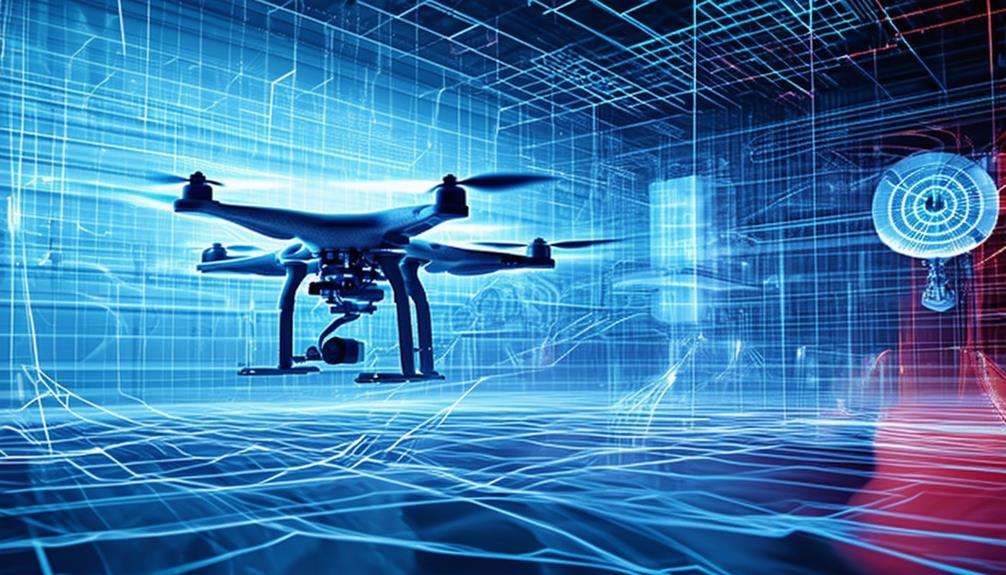
Signal interference techniques are vital for disrupting communication between a drone and its operator. By emitting electromagnetic noise, these methods can compel a drone to land or return to its home point. Additionally, GPS spoofing can misguide drones by providing false location data, thereby enhancing the effectiveness of anti-drone measures.
Signal Interference Techniques
Signal interference techniques, such as jamming, effectively neutralize drones by emitting electromagnetic noise on the same frequencies used for drone communication. By disrupting the link between the drone and its operator, jamming ensures that the drone cannot receive commands, thereby incapacitating it. These devices are designed to target specific frequencies, ensuring that other critical communication systems remain unaffected.
Jamming technology is available in both stationary and portable forms, providing flexibility in deployment. Portable jammers are convenient for on-the-go use, ideal for quickly addressing threats in various sensitive areas. Stationary jammers, on the other hand, are suited for long-term protection of fixed sites like airports and government buildings.
Types of Jamming Devices:
| Type | Description |
|---|---|
| Stationary | Fixed installations for long-term area protection. |
| Portable | Handheld units for flexible, mobile deployment. |
| Directed | Focused jamming towards a specific target. |
| Omnidirectional | Broad-spectrum jamming covering wide areas. |
Utilizing signal interference techniques is essential for safeguarding sensitive zones from unauthorized drone activities. By mastering the use of jamming and disruption technologies, you can significantly enhance security measures against potential drone threats.
GPS Spoofing Methods
GPS spoofing, through the strategic use of jamming and signal manipulation, can effectively compromise a drone's navigation system, preventing it from reaching its intended destination. By emitting false GPS signals, one can disrupt a drone's ability to accurately determine its location. This interference can cause the drone to lose control or land prematurely, making it a highly effective counter-drone technique.
Jamming works by overwhelming the drone's GPS receiver with conflicting signals, confusing its navigation system. Drones that rely heavily on GPS for navigation and control are particularly vulnerable to this method. Disrupting GPS signals can prevent drones from entering restricted areas or carrying out malicious activities, making GPS spoofing an invaluable tool for protecting sensitive locations and ensuring security.
Using GPS spoofing through jamming allows for the efficient neutralization of unwanted drones. It's a proactive counter-drone technique that exploits the drone's dependency on accurate GPS signals. By manipulating this reliance, one can steer drones off course or force them to land, thereby mitigating potential threats. This method is crucial for maintaining control over airspace and ensuring safety.
Advanced Countermeasures
In the domain of anti-drone technology, advanced countermeasures such as GPS spoofers, High Power Microwave (HPM) devices, and high-energy lasers play a crucial role in neutralizing unauthorized drones. GPS spoofers send false signals to confuse a drone's navigation system, causing it to veer off course or land prematurely.
HPM devices emit electromagnetic pulses to disrupt the drone's electronic systems, rendering them inoperable.
For a more physical approach, nets and net guns capture drones by shooting a net to entangle and immobilize them. High-energy lasers offer a destructive solution by targeting and damaging a drone's structure or electronic components with focused laser beams. Cyber takeover systems can intercept and hijack a drone's radio frequency transmissions, allowing control of the rogue device.
Each method addresses a different aspect of drone neutralization, providing a variety of tools for different threats. Whether facing a GPS-based intrusion or a complex electronic threat, these advanced countermeasures offer robust solutions to keep unauthorized drones at bay.
Integration and Applications

As anti-drone technologies evolve, the integration of radar, RF analysis, visual recognition, and AI/ML ensures comprehensive detection and rapid neutralization of potential drone threats. This multi-faceted approach enhances the tracking capabilities of anti-drone systems, safeguarding critical infrastructures, borders, military bases, and VIPs. Specialized software coordinates these diverse hardware sensors to identify specific drone models, enabling swift and effective responses.
| Technology | Functionality |
|---|---|
| Radar | Detects drone presence and movement |
| RF Analysis | Identifies and tracks drone signals |
| Visual Recognition | Verifies and classifies drone models |
| AI/ML | Enhances detection and response accuracy |
Radar systems are crucial for the initial detection of drones, providing real-time data on their locations and movements. RF analysis complements radar by tracking the specific frequencies used by drones, allowing for precise identification. Visual recognition systems further classify and verify drone models, ensuring accurate threat assessment. AI/ML technologies enhance these capabilities by analyzing data patterns, identifying specific drone models, and predicting potential attack trajectories, thereby strengthening protection strategies.
These integrated anti-drone systems are essential for maintaining safety and security across various applications. By leveraging the combined power of radar, RF analysis, visual recognition, and AI/ML, comprehensive drone detection and effective threat neutralization are ensured, supporting the protection of critical assets and individuals.
Conclusion
Anti-drone technologies offer comprehensive protection against unauthorized drones. They utilize radar for real-time tracking, RF analysis for threat identification, and optical and infrared sensors for enhanced surveillance.
Jamming devices disrupt drone communications, while advanced countermeasures like GPS spoofing and high-energy lasers neutralize threats effectively. Integrating these systems ensures robust and reliable defense, securing your airspace from drone intrusions.

